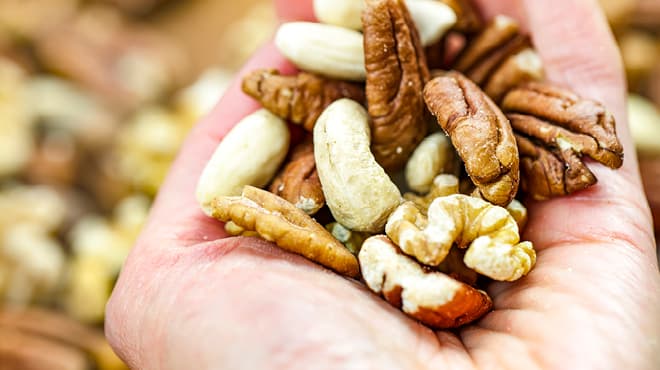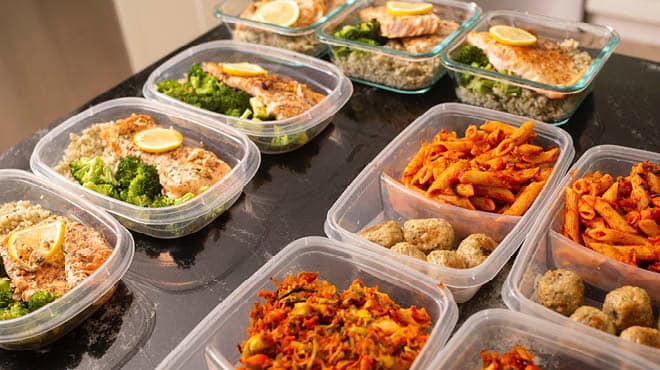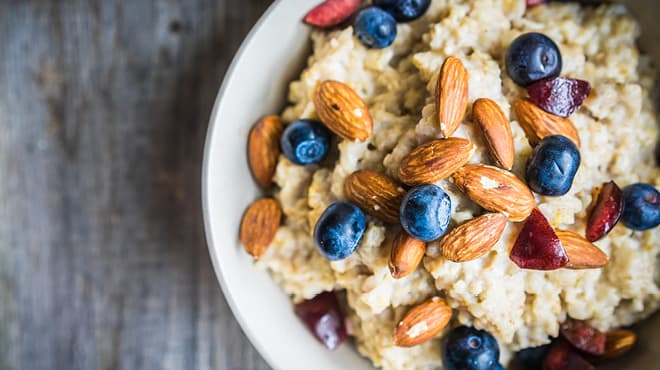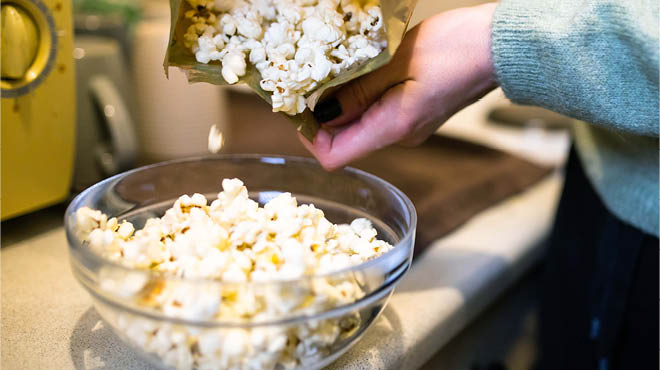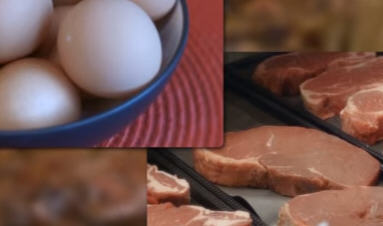Recent Posts
Tips for cooking for one or two

Cooking for one or two doesn’t mean you have to let your health go by the wayside and resort to meals of cold cereal, grilled cheese and canned soup, or microwave meals. With some helpful tips, you can be cooking healthy and efficiently for a smaller household in no time.
Meal planning for one or two
Good health depends on eating a diet made up of a variety of nutritious foods, including carbohydrates, proteins and fats in the right balance. Planning your meals is important, and following the plate method can make meal planning simple.
Divide your plate using the following food-choice guidelines:
- Fill half of your plate with vegetables and fruit.
- One-quarter of your plate with protein rich foods.
- One-quarter of your plate with a starch.
To keep your options healthy, make at least half of your grains whole grains, vary your veggies and fruits (eat the rainbow), get calcium-rich foods with low-fat dairy and go lean with the protein. Find more information at ChooseMyPlate.gov. Remember to choose lots of non-starchy veggies for their nutritious benefits and to keep calories under control.
To make sure your portions are adequate but not excessive, use the following visual cues:
- Vegetable servings — the size of a baseball
- Fruit servings — the size of a tennis ball
- Carbohydrates or grain servings — the size of a hockey puck
- Protein or meat servings — the size of a deck of cards
- Fat servings — the size of one or two dice
When deciding what will be on your menu, start by finding recipes you enjoy making. You can find inspiration in cookbooks, magazines or online. Make sure to plan some days for leftovers, especially those days when you might be too busy to cook. Remember, protein should be an accompaniment to your meal, with veggies serving as the entree. So, start with veggies and plan other items around them.
Shopping for one or two
When cooking for a smaller household, it makes sense to shop the bulk bins or salad bar. That way you can get just the amount you need to prevent waste. Sure, you might pay a little more per pound, but if you actually use what you buy, you’ll be saving money in the end. You can also use the deli counter, where you can purchase only what you need; for example, a single chicken breast, one-quarter pound of meat or just a few slices of cheese. These smaller portions can keep you from the boredom of eating the same foods day after day. If you’d still rather buy larger packages, try buying in bulk and freezing smaller portions, splitting groceries with a friend, or, better yet, cooking meals together with a friend or neighbor.
Cooking for one or two
Try batch cooking, where you cook once and eat multiple times. Here are a few suggestions:
- Make a big batch of homemade soup or chili and freeze in individual portions. Muffin tins work well for this.
- Look at making a batch of brown rice and using some for a side item one day, in a casserole the next and in a stir fry the day after.
- You can make meatloaf and divide it in half. Use half for meatloaf and roll the other half into meatballs and freeze.
- Cook a pound or two of meat or a whole chicken and divide it up for casseroles, tacos, salads, etc. Keep what you can use within three to four days in the fridge and freeze the rest.
- Use extra pasta for a cold salad the next day.
- Make a roast in the crockpot one day and slice up left overs for sandwiches later. You can also freeze it in individual portions for a quick reheat later in the week.
Reducing recipes
If you enjoy cooking every day or you don’t have much freezer space, try reducing recipes using these tips:
- If a recipe calls for three eggs, use two eggs and subtract two to four tablespoons of liquid.
- If a recipe calls for a half can of beans or pumpkin, use half and refrigerate or freeze the rest.
- Remember, there are 16 tablespoons per cup, three teaspoons per tablespoon, eight fluid ounces per cup and two tablespoons per fluid ounce.
- Make sure to monitor a reduced recipe’s cook time more closely, as it will cook faster (likely five to 10 minutes earlier).
Kitchen equipment for smaller meals
Instead of a large oven, here are a few options to look at when preparing your meals:
- Toaster oven. A toaster oven allows you to cook all sorts of single-serve items without heating up your kitchen. You can make small batches of one to two cookies, warm up a single serving of pizza or bake a piece of fish or chicken.
- Indoor single-serving grill. This tool allows for quick cooking of single-serve items such as a burger or chicken breast.
- Crockpot. A crockpot is great for batch cooking. It allows you to throw ingredients together and forget about it until hours later.
- Ice cube trays and muffin pans. These items can be used for freezing leftovers. If you have leftover tomato sauce, freezing in an ice cube tray makes convenient portions for later. If you freeze soup in muffin tins, you can freeze the meaty part of the soup separate from the broth and combine them for a single bowl of soup at a later time. Once frozen, you can remove the cubes or muffins from the tray or pan and store together in a zipper-top freezer bag.
Don’t know how to cook?
Try a cooking class or consider a meal service that delivers healthy meals to your door. There are also companies that will ship recipes with all the prepped ingredients to your door so all you have to do is cook the meal. You can also consider freezer meal classes, which are available at some local grocery stores. Just package the meals for one or two.
Don’t want to cook?
If you still plan on buying frozen or convenience meals after all these ideas, make sure to check the nutrition information and compare labels. If you have diabetes, pay special attention to the total carbohydrates listed on the package. If you have high blood pressure or are on a heart-healthy diet, watch for sodium, as well as fat content — especially saturated fat.
Keeping your food safe
Be sure to refrigerate perishables in shallow dishes within two hours. Eat leftovers within three to four days or freeze. Reheat leftovers to 165 degrees Fahrenheit. Thaw frozen foods on the bottom shelf in the fridge, not on the counter.
Easy meal ideas
To help spur easy meal ideas, see the following simple choices from each food group. Try to include a minimum of three different food groups at each meal. Be creative.
Easy proteins:
- Eggs. They’re always a quick, easy choice. Keep hardboiled eggs in the fridge, and enjoy them as a deviled egg, egg salad or just as is.
- Chicken breasts. Bake extra and freeze individually — chopped or whole.
- Ground beef or turkey. Brown extra and repackage into small amounts to make tacos, casseroles, spaghetti, salads, etc.
- Low-sodium tuna, canned in water. This high-protein option makes a quick sandwich or salad.
- Frozen fish. It can be cooked quickly and even enjoyed cold the next day.
- Canned black, red, kidney, chili beans (rinsed) and lentils. These are great vegetable sources of protein.
- Unsalted nuts or natural nut butters. Nuts are convenient and healthy
Easy starches:
- Baked potatoes — microwave and top with leftover chili to add extra flavor
- Whole-grain pasta, brown rice, barley, quinoa
- Whole-grain bread or crackers
- Whole-grain cereals
- Whole-grain tortillas
- Microwaveable rice pouches
- Oatmeal
Easy fruits and veggies:
- Pre-washed, pre-cut fruits and veggies
- Ready-to-eat salad bags or kits
- Baby carrots
- Salad bar items
- Frozen — without sauces, sugar or salt
- Steamer bags
- Canned — in its own juice or without salt
- Fruit cups or unsweetened apple sauce
Easy dairy:
- Natural cheese or string cheese
- Yogurt
- Cottage cheese
- Low-fat milk
Kristi Wempen is a clinical dietician at Mayo Clinic Health System in Mankato.


